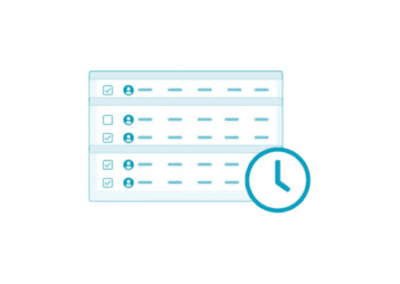Unfortunately, employee turnover is a part of most employee lifecycles. Whether it’s reflective of the company, or the journey of the employee, it’s relatively common across most industries. This is particularly true for millennial employees as they move through their careers.
According to the U.S Bureau of Labor Statistics, the industries with the highest employee turnover rates in the U.S. include Manufacturing, Retail Trade, Transportation, Warehousing, and Utilities, Professional and Business Services, Healthcare and Social Assistance, Accommodation, and Food Services, and Security.
Generally, organizations battle to keep employee turnover low, and employee retention high… but why?
What is Employee Turnover?

Employee turnover is the term used to describe the number or percentage of workers that leave a company and need to be replaced within a certain period of time. In other words, it is the loss of talent in the workforce over time. Everything from resignations to terminations falls under employee turnover. Always consider these when calculating your own employee turnover rate.
Why Care about Employee Turnover
Employee turnover is one of the most underestimated and understudied costs of operation. It can negatively impact both the short and long-term success of your business. Therefore, it’s amazing how few organizations are even aware of the costs that they are incurring because of high turnover.
Surveys have shown that only 17% of organizations are aware of the direct employee turnover costs. When it comes to indirect costs, that number drops to 9%. If you want some real-life figures, Gallup estimates that U.S businesses lose a trillion dollars every year due to voluntary employee turnover. We’ll dig deeper into the costs of high turnover later.
What causes Employee Turnover?
Although you cannot avoid some level of employee turnover, it is important to recognize it. You also need to understand why employees would choose to leave your company. Keeping track of your annual turnover rate and knowing the causes will allow you to make changes within your organization. These changes might reduce voluntary and involuntary turnover.

Essentially, employee engagement and employee turnover are directly linked. Here are some of the main causes;
- Performance Recognition & Feedback
- Lack of Opportunities for Progression
- Workload & Work-Life Balance
- Poor Staff Selection
PERFORMANCE RECOGNITION & FEEDBACK
Believe it or not, simply failing to recognize your employees’ work efforts can lead to increased employee turnover. In fact, 79% of people who quit their jobs cite “lack of appreciation” as their reason for leaving. Giving employees feedback is often overlooked, particularly when employees are doing well.
Employees sometimes view a lack of feedback as a lack of appreciation. This can create feelings of hostility from high performing employees. Appreciating your staff may seem mundane, but it can make a huge difference in their employee experience and desire to stay longer.
79% of people who quit their jobs cite ‘lack of appreciation as their reason for leaving.
O.C TANNER LEARNING GROUP
LACK OF OPPORTUNITIES FOR PROGRESSION
Research shows that career progression and advancement opportunities are important to most employees. A recent study on the attitudes of employees towards career advancement noted that 37.55% of respondents said that it would “very much” affect their decision to leave. Another 23.21% said it would “somewhat” affect theirs. Giving the opportunity for growth within the company gives employees less of a need to look elsewhere.
WORKLOAD AND WORK-LIFE BALANCE

Employees consider work-life balance a very important factor in their intentions to quit. Generally, no amount of pay will outweigh the negative impact of an increased workload or a poor work-life balance. In fact, employees who perceive higher levels of balance in their work and life have lower intentions to quit their jobs at all.
POOR STAFF SELECTION
Most hiring managers would say they are great at their jobs and know exactly what to look for while hiring. However, 74% of employers say they have hired the wrong person for a position during a recruitment process. Of course, this will sometimes result in the employee being let go, but oftentimes the employee will realize they are a poor fit themselves and leave of their own accord.
JUST THE TIP OF THE ICEBERG
So many other factors contribute to employee turnover, such as low pay, being denied a pay rise or promotion, poor leadership, poor working conditions, and changing career goals. As an employer, it’s crucial to communicate with employees who decide to leave their roles and discover the issues within your own organization.
The Consequences of High Employee Turnover
We’ve mentioned and we all know that employee turnover is extremely costly to employers. In order to get the full picture of the consequences and costs of the issue, we need to look at both direct and indirect costs. Indirect costs are often completely overlooked and are the most costly and time-consuming.
Replacing a highly educated C-Suite employee earning $100,000 per year could cost you over $21,000.
DIRECT COSTS

Employee turnover brings its fair share of direct costs with it. First, separation costs might come from severance pay, exit interviews, and everything else involved in involuntary turnover. Next, and often the largest, are the replacement costs covering advertising the position and conducting interviews to fill the role.
In addition to that, there are also the costs of training which cover things like orientation, induction, and on-the-job training. These replacement costs are often the highest of the turnover process and often go uncalculated.
To further illustrate the direct costs of replacing employees, we can look at it as a percentage of the salary for the role that is being filled. Research indicates that the direct cost of replacing an employee depends on their position. These costs range from 16% to 21.3% of the salary and continue to increase as the salary and skill level increases.
The average cost falls around the 21% mark. In other words, replacing a highly educated C-Suite employee earning $100,000 per year could cost you over $21,000. This often-uncalculated replacement cost can cost organizations substantially, removing their bottom line.
INDIRECT COSTS
As we know, indirect costs are much more difficult to measure. However, they are very real and can be more expensive than necessary if they are overlooked. First, let’s consider the lost productivity from employee turnover.
As soon as an employee decides they might leave their role, they will become disengaged and less productive. Time will be spent looking for new positions, and time off may be taken for interviews. All of this time is at the cost of the employer.
Not only will indirect costs come from the departing employee, but high turnover rates might cause existing employees to question their own position at the organization. This, along with a loss of organizational knowledge, reduced morale and increased gossip, will seriously impact your business’s productivity and customer relations.
The Significance of Year One
An interesting fact that actually can be quite useful in helping deal with employee turnover costs is knowing when your employees are leaving. The majority of all turnover– 52%, occurs in the first year of employment. In fact, it actually peaks right at the 12-month mark at 27%. Therefore, when a new employee starts work on their first day, they represent pure cost and a lot of potential.

A time-to-productivity analysis can give you an indication of when an employee’s productivity has increased to a point where their contribution exceeds their cost. For example, if threshold productivity occurs on average at the six-month mark, anyone who leaves with less time on the job is to some degree, a financial loss.
The point to take away from this data is that your retention strategies should start on day one. Employee engagement, flexible schedules, providing a positive work environment, and setting fair compensation should be implemented and evaluated on a year-long basis.
For example, if your company focuses its recognition and retention strategies on one yearly event, such as an awards dinner, it may be too late to retain a year one employee from looking elsewhere for employment. In order to obtain every employee’s potential; focus on keeping them in the family from day one.
How to Reduce Employee Turnover
Having examined the potential reasons for employee turnover, you should be able to create a tailored plan to improve turnover rates in your organization. Although this will look different for each unique business, there are steps that all employers should be taking to avoid high rates of employee turnover.
SHOW RECOGNITION AND APPRECIATION
Countless research has been carried out to prove that regular, simple displays of appreciation are all it takes to satisfy employee needs. One study shows that 50% of employees believe simply being thanked by managers would improve their relationships and build trust with their higher-ups. Whether it’s 1:1 interactions or companywide initiatives, ensuring employees feel appreciated is crucial.
A simple but effective way to show appreciation and discourage turnover is to offer incentives to employees based on years of service. That way, employees are more likely to remain in their positions and will feel a sense of appreciation after working there for a long time. Everybody wins!

INVEST IN EMPLOYEES AND PROMOTE INTERNALLY
Now that we know that employees consider career opportunities in their decision to leave or not, you can take advantage of the opportunities that come from this. One way to ensure that your employees know you care about their careers is to invest in them and their training and education.
By playing an active part in their professional development to demonstrate you are invested in their success, you will see an increase in their company loyalty. The 2021 Workplace Learning Report from LinkedIn backs this up, noting that 94% of employees would stay with a company longer if there was an investment in learning.
ENCOURAGE & FACILITATE WORK-LIFE BALANCE
Creating a workspace that facilitates a positive work-life balance is beneficial in more ways than one. While also working to discourage voluntary turnover, encouraging work-life balance can also improve employee engagement and productivity. 68% of employees say poor work-life balance negatively impacts their morale and motivation at work. This number is only likely to increase as there is a greater emphasis on work-life balance worldwide.
Fortunately, for now and in the future, there are a variety of ways to encourage and facilitate a positive work-life balance;
Flexible scheduling;
Depending on your industry, offering flexible scheduling is a great way to give employees autonomy. Look at methods such as self-scheduling and shift bidding as means to facilitate this!
Work from home;
Again, this will depend on your industry, but consider allowing your employees to work from home. Even offering a combination of in-office and work-from-home is sufficient.
Personal time off;
Although this seems like an obvious step, it’s important for employees to know that they can take personal time off when needed. Many employers discourage using personal days, but trends are changing, and employees expect more paid time off for personal use.

Restrict work communications;
Although this is a newer idea, some companies are adapting to restrict work-related communications outside of work hours. This helps employees create a better sense of a work-life divide and avoid feeling like they are working all of the time. This also makes it more likely that in case of emergencies, your staff will be more willing to help out after hours since they feel their time is being appreciated.
Review workloads;
How often do you check in on your employees to ensure they’re not drowning in their workload? Probably not enough. Ensuring your employees have a manageable workload and aren’t being forced to start early or stay late is very effective in ensuring they feel balanced and productive.
Social outings on work time;
Reward your employees with social outings and team-building activities during work time! While some employers do these activities outside of work hours, this eats into employees’ personal time, and they often end up not attending or resenting the fact that they have to attend.
Perfect your selection process;
Another great way to avoid turnover is hiring the best staff member for the role and the company’s culture. In order to avoid wrong-fit employees departing and forcing you to go through the costly hiring process again, take time to review and refine your employee selection process. This won’t be easy, but your time and effort will pay off in the long run.
A cheap and effective way to improve your process is to welcome employee referrals; 48% of businesses say their top-quality hires come from them. It is also important to ensure that candidates fit your company culture and ask open-ended questions that prompt the candidate to reveal what they’re truly looking for. This will help you eliminate any employees that don’t share your organization’s values.
There is no guarantee that employee turnover will disappear if you take all these steps. It is a reality that despite every effort, people will come and go as is human nature. However, the goal should not be to eliminate employee turnover altogether. Work to understand why employees are leaving and what you can do to encourage employees to stay.
Simply being aware of these issues allows you to prepare and adapt your organization to foster long-lasting employee relationships. Celayix is a leader in workforce management and can facilitate your efforts to create a balanced, employee-centric workplace. If you’d like to learn more about how we can help, get in touch with a Solutions Advisor today.





